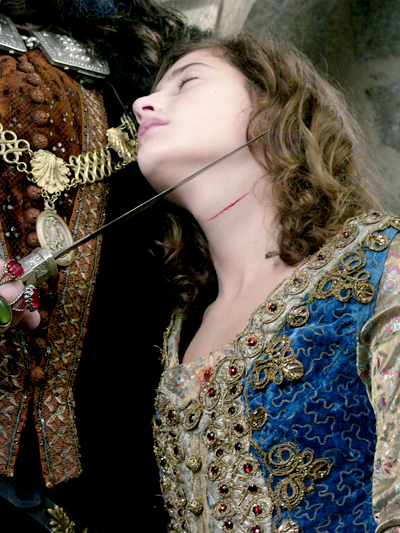|
Reviews of Recent Independent, Foreign, & Documentary Films in Theaters and DVD/Home Video
BLUEBEARD Before fairytales were castrated and childproofed by the likes of Disney, the princess didn’t always live happily ever after. In fact, sometimes she was brutally murdered and strung up on a hook by her psychopathic husband. This is the case in “Bluebeard,” the grizzly, allegedly true story penned by French author Charles Perrault about a lavishly rich, blue-bearded brute who married and killed a slew of young girls sometime, somewhere in medieval France. (Actually, the real Bluebeard may have raped and killed thousands of young boys, so in that sense you could say the tale has already been relatively rose-tinted.) One would think that Director Catherine Breillat’s wanton reputation as a sexual provocateur, combined with her violent subject, would be the perfect union of sex and murder for the voyeuristic viewer. So it comes as a great surprise that the French madame of perversity (Romance, Fat Girl) takes a decidedly chaste and minimalistic approach in this unusual project. Occasionally, the flat-lined rhythm of the film is interrupted by a dose of random, peripheral violence (a headless goose thrashing about), but in general, Breillat opts out of the ample opportunities for shock value. The director’s famed, hyper-reflective interest in the female psyche is her lens for this simple, though gruesome, tale. She tells it from the perspective of two young sisters who find a copy of “Bluebeard” in a dusty attic. The feisty and fearless younger of the two, modeled after the director’s own childhood experiences, reads the frightening tale aloud despite her sensitive older sister’s pleas for her to stop. In an uninteresting hodgepodge of life reflecting art, the two sisters within the Bluebeard narrative share a very similar dynamic. After their father dies leaving them penniless, the younger sparkplug (Lola Créton) sets her sights on an infamous wife-murdering nobleman (Dominique Thomas). Seducing him with her sincerity is easy, but stopping him from trying to murder her proves to be a bit trickier. The basic (and very short) fairy tale—bereft of a moral lining or any interesting allegory—is clearly not a serious topic for Breillat. This is suggested by a barren cinematographic style. The made-for-TV scenes feature far too few extras and have the look of a New Jersey Renaissance fair on a poorly attended Tuesday. Perhaps the
film is more of an homage to the memory of reading this story at a
tender, impressionable age, rather than a tribute to the story itself. And though we may be curious to discover the formative ingredients of Breillat’s unique perspective on sex, women, and relationships, I would
have preferred to have read a short interview on the subject than to
have sat
through this bland film.
Yana Litovsky
|


